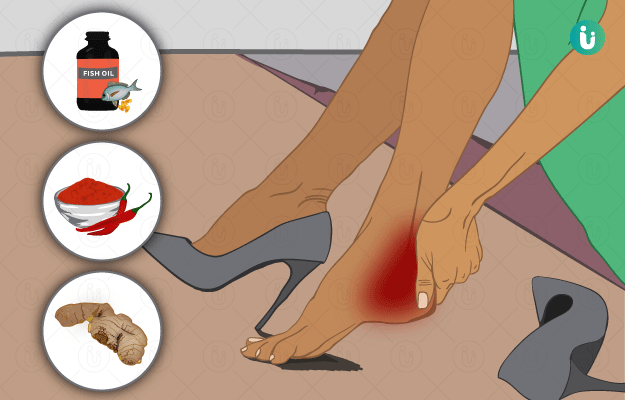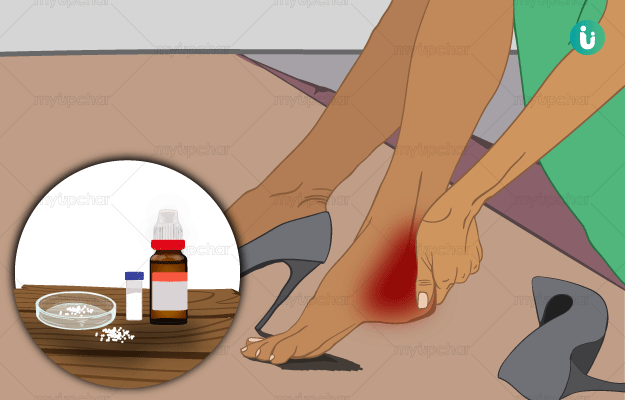Heel pain, referred to as parshni shula in Ayurveda is a common condition that causes immense discomfort in the heel bone, making it difficult to walk or stand in severe cases. Pain in the heel bone may occur due to numerous reasons like excessive stress on the heel, improper footwear and walking barefoot on hard surfaces. However, it is also associated with conditions like heel spurs and plantar fasciitis.
Ayurvedic procedures that can help in the treatment of parshni shula include abhyanga (oil massage), swedana (sudation or sweat therapy), virechana (purgation), basti (enema), raktamokshana (bloodletting), lepa (coating the affected body part with medications) and agni karma (thermal cauterisation). Some of the herbs and medicines used to treat heel pain are chitraka (leadwort), rasna (Indian camphorweed), eranda (castor), yogaraja guggulu and dashmoolarishta.
- Ayurvedic view of heel pain
- Ayurvedic treatment for heel pain
- Ayurvedic herbs and medicines for heel pain
- Dietary and lifestyle changes for heel pain patient as per ayurveda
- How effective are ayurvedic medicines and treatments for heel pain
- Side effects and risks of ayurvedic medicine and treatments for heel pain
- Takeaway
Ayurvedic view of heel pain
Ayurveda describes numerous causes of heel pain, thought it is primarily considered to be a result of aggravation of the vata dosha, which leads to vatakantaka with symptoms such as a pricking pain in the heel. Depending on the cause of occurrence, vatakantaka can be of three types:
- Calcaneal (heel) spurs: As per Ayurveda, heel spurs can be correlated with asthi-snayugata vata (vata that affects the bones and muscles) and usually occurs due to the localisation of the aggravated vata in calcaneal bone, causing bone degeneration and heel pain. It is mainly characterised by a pointed bony outgrowth over the heel bone.
- Plantar fasciitis: Plantar fascitis refers to inflammation in the plantar fascia, a tissue which is present at the base of feet. Walking on an uneven floor, structural deformity of the foot, excessive walking or other types of strain on feet, which cause aggravation of vata dosha are responsible for this condition.
- Achilles tendon bursitis: A fluid-filled sac present at the back of the heel is called bursa. It acts as a cushion between the Achilles tendon and heel bone. Excessive walking or running can cause inflammation of this bursa, leading to a condition called Achilles tendon bursitis. Ayurveda links this condition to vatakantaka as it also occurs due to aggravation of vata and causes pricking pain in heel.
Other causes of heel pain include incorrect walking habits and improper consumption of food. Research indicates that women are more prone to calcaneal spurs than men because of high-heeled footwear, which exerts more pressure on the calcaneal bone and stretches ligaments.
Ayurvedic treatment for heel pain
- Abhyanga
- In this procedure, medicated oils are poured and massaged over the body. It aids in cleansing the meridians and bringing balance between the sensitive points of body.
- It is primarily used to stimulate the lymphatic system and improve the functioning of skeletal muscles, brain and bone marrow.
- It improves nutrient supply to different parts of body and expels toxins.
- Pinda taila abhyanga is useful in the management of heel pain.
- Swedana
- Swedana is a sudation therapy that forms the preparatory step for panchakarma procedures of virechana and basti.
- Swedana procedure varies depending on the condition of the individual to be treated.
- It is mainly employed to liquefy ama (toxins), dislodge it from naadis (channels), and bring it to the digestive tract, from where it can be easily eliminated using panchakarma procedures.
- This process helps in relieving heaviness, coldness and stiffness in body.
- Virechana
- Virechana involves the use of herbs and their combinations to induce purgation. Herbs used for this procedure are selected on the basis of individual clinical condition.
- It is mainly used in the elimination of aggravated pitta dosha, but it can also be employed to treat disorders due to increased vata and kapha doshas.
- Virechana makes an excellent detoxifying procedure as it dislodges and eliminates toxins from the body.
- It cleanses the digestive tract and is hence performed after swedana (which transfers the toxins to the digestive tract).
- In addition to heel pain, it can also be used in the treatment of poisoning, skin disorders, chronic jaundice and epilepsy.
- Basti
- Basti is a purification procedure, which involves the introduction of herbal enemas in the form of decoctions and oils.
- It cleanses intestines and clears the bowel, thereby eliminating the aggravated doshas and ama from body.
- Basti is primarily used in the management of vata disorders. It can also treat conditions involving an imbalance of other doshas with vata imbalance as the predominant cause.
- It alleviates pain and, thus, is effective in treating calcaneal spur, plantar fasciitis, Achilles tendon bursitis, arthritis, gout and sciatica.
- Raktamokshana
- It is an Ayurvedic procedure that involves the removal of toxic blood from various sites in the body. The materials that can be used to remove blood are cow's horn, leeches and dried bitter gourd.
- Raktamokshana detoxifies the body by removing toxins.
- It is useful in treating blood-borne diseases and diseases due to excess vata and pitta doshas such as calcaneal spur, plantar fasciitis, Achilles tendon bursitis, inflammation, arthritis and skin diseases.
- Lepa
- This procedure involves the application of herbs and different combinations of herbs on the affected area of the body. The herbs are used based on the disorder to be treated.
- Lepas are like topical creams or pastes and are mainly used to reduce inflammatory swellings. Some of the common ingredients of a lepa are vacha (calamus), barley and amalaki (Indian gooseberry).
- Hingvadi lepa is useful in treating heel pain caused by conditions such as calcaneal spur and plantar fasciitis.
- Agni karma
- Agni karma involves therapeutic burning of the most painful point of the joint.
- It is useful in the treatment of calcaneal spur, plantar fasciitis and Achilles tendon bursitis.
- It is also effective in the management of osteoarthritis, rheumatoid arthritis and gout.
Ayurvedic herbs and medicines for heel pain
Ayurvedic herbs for heel pain
- Chitraka
- Chitraka acts on the nervous and female reproductive systems. Roots of this herb are mainly used in the management of heel pain.
- For effective pain relief, chitraka roots are applied in the form of a lepa to the affected area.
- Chitraka creates local heat, increases blood circulation and accelerates the metabolic processes, This lowers the concentration of ama from heel, thereby reducing pain.
- Rasna
- The roots of this herb have analgesic (pain-relieving) and anti-inflammatory properties. It is mainly effective in the management of vata disorders like rheumatoid arthritis and gout.
- Rasna can also be used for treating cough, fever and asthma.
- The pain-relieving and vata-balancing properties of this herb make it an effective herb for the management of vatakantaka.
- Eranda
- Eranda acts on the nervous, female reproductive, digestive, and urinary systems and has pain-relieving, purgative, and nervine properties.
- It is one of the main herbs used in the management of swelling.
- Eranda is also known as the “king of purgatives” or “king of vata disorders” as it is useful in inducing purgation, eliminating ama from body, and pacifying the aggravated vata.
- It helps relieve pain and swelling in the joints. Therefore, it can be used in the management of diseases like sciatica, rheumatism, calcaneal spur, plantar fasciitis and Achilles tendon bursitis.
Ayurvedic medicines for heel pain
- Yogaraja guggulu
- Yogaraja guggulu is a polyherbal formulation prepared from guduchi (heart-leaved moonseed), gokshura (small caltrops), twak (cinnamon), pippalimoola (long pepper roots), chitraka (leadwort), rasna, parsika yavani (stinking nightshade), guggulu (Indian bdellium-tree), vidanga (false black pepper) and shatavari (hundred roots).
- It relieves pain and inflammation and can be used to treat many vata diseases.
- Yogaraja guggulu balances vata dosha and removes ama from body. relieving pain in the affected bones and joints.
- Dashmoolarishta
- Some of the ingredients of this formulation are dashmoola (10 roots), haritaki (chebulic myrobalan), honey, jaggery, lavang (clove) and pippali (long pepper).
- It is useful in vata disorders like rheumatic arthritis, calcaneal spur, plantar fasciitis and Achilles tendon bursitis.
- Dashmoolarishta is also recommended for the treatment of cough, bronchitis, dyspnoea, vomiting, dysuria, gastric disorders and anaemia.
- As a general tonic, this medicine can be used to improve physical strength, vigour and vitality, especially after childbirth.
As treatments vary according to numerous factors and an individual’s prakriti (constitution), consult a qualified Ayurvedic doctor for the appropriate medications and treatments for your specific complaints.
Dietary and lifestyle changes for heel pain patient as per ayurveda
Do’s
- Give proper rest to your heel.
- Use comfortable footwear with heel and arch support.
Don’ts
- Do not stand for a long time.
- Do not walk barefoot, especially on hard floor.
- Do not wear footwear with high heels.
How effective are ayurvedic medicines and treatments for heel pain
A clinical study involving 30 participants, nine men and 21 women, indicated the efficacy of pinda taila abhyanga, rasnadi swedana and hingvadi lepa in the management of vatakantaka. Parameters like pain, burning sensation, swelling, numbness, pruritus, skin hardness and cracking were observed pre- and post-treatment. Significant improvement was reported in all the symptoms within a month of the treatment. It was concluded that this particular set of procedures, when given together is effective in the management of vatakantaka.
In another study, a 40-year-old woman with pain and localised tenderness in both heels due to calcaneal spur was treated using agni karma. Agni karma was performed four times in a month, and yashtimadhu (mulethi) powder was sprinkled on the wound after the therapy. Application of honey and ghee (clarified butter) was also advised one day after agni karma. The wound was reported to be healed within a week, and scars disappeared within 15 days after the treatment. The study concluded that agni karma is a simple, safe and cost-effective therapy for the management of calcaneal spur.
Side effects and risks of ayurvedic medicine and treatments for heel pain
Although Ayurvedic therapies are natural and effective, certain precautions need to be followed while taking a treatment of herb as they may have side effects and risks, e.g., virechana is contraindicated in children, elderly individuals, pregnant women and individuals who are weak or tired; raktamokshana is not recommended in bleeding disorders, piles, anaemia and conditions in which venipuncture is contraindicated; and eranda should not be used in individuals with kidney, bile duct, bladder or intestinal infections.
Takeaway
Heel pain is a common problem that affects the calcaneal bone. When left untreated, heel pain affects basic movements like walking. Unique and natural Ayurvedic therapies such as abhyanga, lepa and agni karma can be used to treat heel pain and improve general strength. However, instead of self-medicating, consult an Ayurvedic physician to get the right remedy on the basis of your disease symptom and prakriti.
Find Ayurvedic Doctor in cities
Doctors for Ayurvedic medicine, treatment and remedies for Heel Pain

Dr. Ayush Bansal
Ayurveda
2 Years of Experience

Dr. Megha Sugandh
Ayurveda
6 Years of Experience

Dr. Nadeem
Ayurveda
3 Years of Experience

Dr.Ashok Pipaliya
Ayurveda
12 Years of Experience
References
- Dr. Suraj Rubab Shaikh,Dr. Sandip M. Mali. A Case Study On Agnikarma in Calcaneal Spur (Asthisnayugata-Vata). European Journal of Pharmaceutical and Medical Research. 2017,4(9), 629-631
- Narendar Singh et al. Plantar Iontophoresis with Aqueous Solution of Gugulu In The Management of the Plantar Fascitis: Engendering An Incipient Dimension In Its Management. Journal of Biological and Scientific Opinion Volume 4(1) . 2016
- Dr. Suresh N Hakkandi,Dr. Manjunath Akki,Dr. Bhavana K.S. Conceptual Study On The Management of Vatakantaka. Paryeshana International Journal of Ayurvedic Research September-October-2018, Volume-3, Issue-1.
- Pooja Rohilla, Raghavendra Naik,RN Acharya. Single herbal remedies for Sandhivata (Osteoarthritis): A review on evidence based researches in Dravyaguna department of IPGT & RA, Jamnagar . International Journal of Herbal Medicine 2016; 4(5): 97-101
- Pramodani et al. A Clinical Study To Evaluate The Efficacy of Selected Treatment Modality In The Management of Vata Kantaka. International Journal of Research -Granthaalayah Vol.5 (Iss.1): January, 2017
- Pravin Jawanjal. Effect of Chitrakamula ( Plumbago Zeylanica Linn) Lepa In the Management of Calcaneal Spur: A Case Study. European Journal of Biological and Pharmaceutical Sciences. 2018, Volume 5, Issue 11 452-453.
- MedlinePlus Medical Encyclopedia: US National Library of Medicine; Bursitis of the heel.
- Nishant Singh. Panchakarma: Cleaning and Rejuvenation Therapy for Curing the Diseases . Journal of Pharmacognosy and Phytochemistry Vol. 1 No. 2 2012













